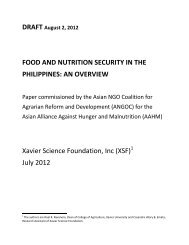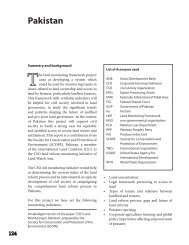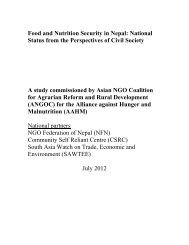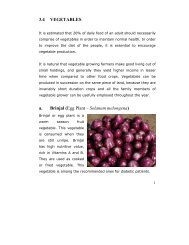Traditional Practices in Agriculture FULL - ANGOC Site
Traditional Practices in Agriculture FULL - ANGOC Site
Traditional Practices in Agriculture FULL - ANGOC Site
You also want an ePaper? Increase the reach of your titles
YUMPU automatically turns print PDFs into web optimized ePapers that Google loves.
6. Vegetable Seed Storage<br />
Method: The vegetable seeds<br />
are normally stored by women<br />
folk for their kitchen garden<br />
requirements by secur<strong>in</strong>g the<br />
seeds of different vegetables <strong>in</strong>to<br />
knots tied around them <strong>in</strong> a white<br />
cloth. While do<strong>in</strong>g so the seeds<br />
are mixed with woodash / dried<br />
neem leaf powder. After this<br />
these are conveniently put <strong>in</strong>to<br />
Bottleguard, spr<strong>in</strong>kled woodash on the top and closed the mouth<br />
of the bottleguard.<br />
Safe Gra<strong>in</strong> Storage Methods for Wheat, Pulses and<br />
Oilseeds<br />
a. After harvest<strong>in</strong>g of Rabi crops like wheat, pulses and oilseeds,<br />
they are cleaned and put <strong>in</strong> an open place for sun dry<strong>in</strong>g. After<br />
dry<strong>in</strong>g, seed gra<strong>in</strong>s are packed <strong>in</strong> jute bags. A store room of<br />
20’x15’ size is used for keep<strong>in</strong>g 50 to 80 qtls of seed. Spread<br />
wheat husk on the floor upto 1-2 feet, after which all bags are<br />
kept at a distance of one foot away from all the walls of the<br />
room. After one layer, spread aga<strong>in</strong> wheat husk of 6” layer,<br />
followed by wheat bags as done earlier. This process is repeated<br />
to accommodate maximum produce till the room is filled, after<br />
9
















